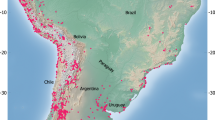Abstract
Analysing the isotope ratio of light elements in human tissue of an unknown person helps to reconstruct the life history with regard to geographical origin and/or typical food supply. In this study the isotope ratios of the bio-elements in hair samples of 111 persons from 13 different countries all over the world were measured with the aim of provenance determination. The results indicated that individuals from Costa Rica and Brazil can be differentiated from typical European individuals by δ13C, Australians by δ34S and δ2H in hair samples. The combination and evaluation of the data by multivariate statistical analysis considerably improved origin assignment. Investigation of hair samples from a number of individuals from one particular region (southern Germany) yielded remarkable variation of isotopic values indicating different nutritional habits. The possibilities and limitations of this method in its current state are demonstrated and discussed.





Similar content being viewed by others
References
Rossmann A, Haberhauer G, Hölzl S, Horn P, Pichlmayer F, Voerkelius S (2000) The potential of multielement stable isotope analysis for regional origin assignment butter. Eur Food Res Technol 211:32–40
Rossmann A (2001) Determination of stable isotope ratios in food analysis. Food Rev Int 17:347–381
Pillonel L, Badertscher R, Froidevaux P et al (2003) Stable isotope ratios, major, trace and radioactive elements in Emmental cheeses of different origins. Lebensm Wiss Technol 36:615–623
Roßmann A, Rummel S, Kupka H-J (2003) Herkunftszuordnung von Milchprodukten. Dtsch Molkereizeitschrift 21:18–23
Balasiu S, Ohsam J, Rossmann A (2004) Isotopenverhältnis-Massenspektrometrie zur Authentizitätsprüfung von Lebensmitteln. Lebensmittel 3:222–223
Schmidt H-L, Roßmann A, Stöckigt D, Christoph N (2005) Herkunft und Authentizität von Lebensmitteln. Chem Unserer Zeit 39:90–99
Richards MP, Fuller BT, Hedges REM (2001) Sulphur isotopic variations in ancient bone collagen from Europe: implications for human palaeodiet, residence mobility, and modern pollutant studies. Earth Planet Sci Lett 191:185–190
Koch PL, Fogel ML, Tuross N (1994) Tracing the diets of fossil animals using stable istopes. In: Lajtha K, Michener RH (eds) Stable isotopes in ecology and environmental science. Blackwell, Oxford, pp 63–92
Schmidt O, Quilter JM, Bahar B et al (2005) Inferring the origin and dietary history of beef from C, N and S stable isotope ratio analysis. Food Chem 91:545–549
Petzke KJ, Boeing H, Metges CC (2005) Choice of dietary protein of vegetarians and omnivores is reflected in their hair protein 13C and 15N abundance. Rapid Commun Mass Spectrom 19:1392–1400
Rauch E, Rummel S, Lehn C, Büttner A (2007) Origin assignment of unidentified corpses by use of light (bio-) and heavy (geo-) elements—a case report. Forensic Sci Int 168:215–218
Thieme D, Rolf B, Sachs H, Schmid D (2008) Correlation of inter-individual variations of amitriptyline metabolism examined in hairs with CYP2C19 and CYP2D6 polymorphisms. Int J Legal Med 122:149–155
Szibor R, Plate I, Schmitterer H, Wittig H, Krause D (2006) Forensic mass screening using mtDNA. Int J Legal Med 120:372–376
Brandstätter A, Parsons TJ, Parson W (2003) Rapid screening of mtDNA coding region SNPs for the identification of west European Caucasian haplogroups. Int J Legal Med 117:291–298
Calì F, Forster P, Kersting C, Mirisola MG, D'Anna R, De Leo G, Romano V (2002) DXYS156: a multi-purpose short tandem repeat locus for determination of sex, paternal and maternal geographic origins and DNA fingerprinting. Int J Legal Med 116:133–138
Forster P, Calì F, Röhl A et al (2002) Continental and subcontinental distributions of mtDNA control region types. Int J Legal Med 116:99–108
Ray DA, Walker JA, Hall A et al (2005) Inference of human geographic origins using Alu insertion polymorphisms. Forensic Sci Int 153:117–124
Sieper H-P, Kupka H-J, Williams T, Rossmann A, Rummel S, Tanz N, Schmidt H-L (2006) A measuring system for the fast simultaneous isotope ratio and elemental analysis of carbon, hydrogen, nitrogen and sulphur in food commodities and other biological material. Rapid Commun Mass Spectrom 20:2521–2527
Benson S, Lennard C, Maynard C, Roux C (2006) Forensic application on isotope ratio mass spectrometry—a review. Forensic Sci Int 157:1–22
Richards MP, Fuller BT, Sponheimer M, Robinson T, Ayliffe L (2003) Sulphur isotopes in palaeodietary studies: a review and results from a controlled feeding experiment. Int J Osteoarchaeol 13:37–45
Crittenden RG, Andrew AS, LeFournour M, Young MD, Middleton H, Stockmann R (2007) Determining the geographic origin of milk in Australasia using multi-element stable isotope ratio analysis. Int Dairy J 17:421–428
Nardoto GB, Silva S, Kendall C et al (2006) Geographical patterns of human diet derived from stable-isotope analysis of fingernails. Am J Phys Anthropol 131:137–146
Acknowledgments
The project was financially supported by The Friedrich Baur Foundation, Munich, and the Police Headquarters of Munich. The samples were partly provided by different Police Departments in Germany, especially from the Police Headquarters of Munich. Scalp hair samples from different parts of the world were collected by members of the Institute of Forensic Medicine, Munich and numerous donors all over the world. Dr. Monika Kriner from the Institute of Medical Statistics and Epidemiology, University of Munich, reviewed the statistical interpretations.
Author information
Authors and Affiliations
Corresponding author
Rights and permissions
About this article
Cite this article
Mützel (Rauch), E., Lehn, C., Peschel, O. et al. Assignment of unknown persons to their geographical origin by determination of stable isotopes in hair samples. Int J Legal Med 123, 35–40 (2009). https://doi.org/10.1007/s00414-008-0286-7
Received:
Accepted:
Published:
Issue Date:
DOI: https://doi.org/10.1007/s00414-008-0286-7




